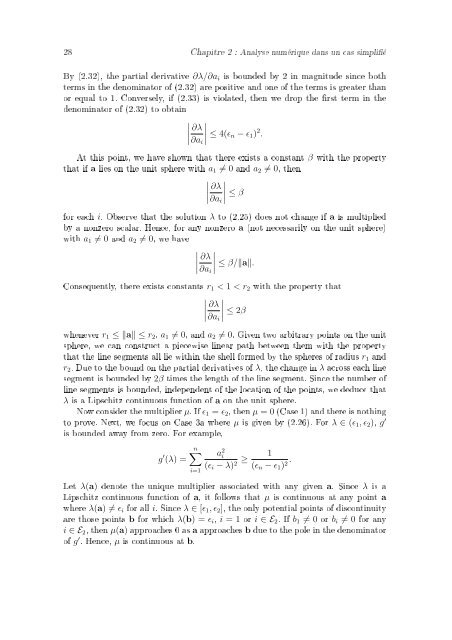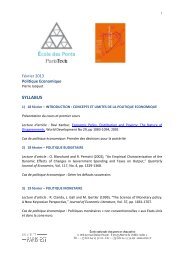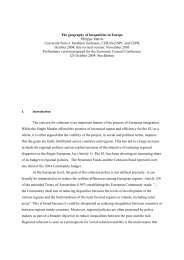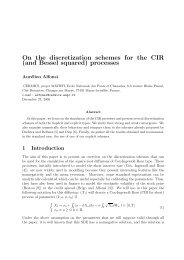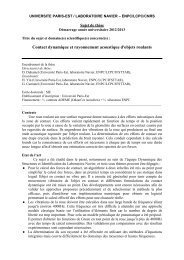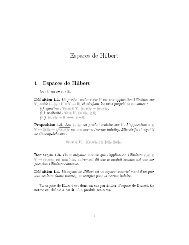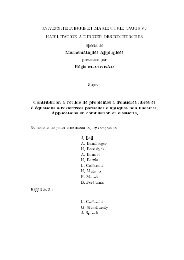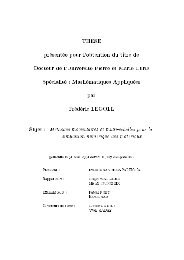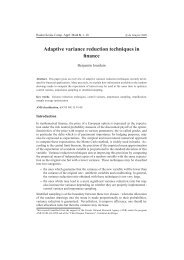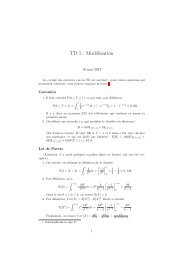Create successful ePaper yourself
Turn your PDF publications into a flip-book with our unique Google optimized e-Paper software.
28 Chapitre 2 : Analyse numérique dans un cas simplié<br />
By (2.32), the partial derivative ∂λ/∂a i is bounded by 2 in magnitude since both<br />
terms in the denominator of (2.32) are positive and one of the terms is greater than<br />
or equal to 1. Conversely, if (2.33) is violated, then we drop the rst term in the<br />
denominator of (2.32) to obtain<br />
∣ ∂λ ∣∣∣<br />
∣ ≤ 4(ɛ n − ɛ 1 ) 2 .<br />
∂a i<br />
At this point, we have shown that there exists a constant β with the property<br />
that if a lies on the unit sphere with a 1 ≠ 0 and a 2 ≠ 0, then<br />
∣ ∂λ ∣∣∣<br />
∣ ≤ β<br />
∂a i<br />
for each i. Observe that the solution λ to (2.25) does not change if a is multiplied<br />
by a nonzero scalar. Hence, for any nonzero a (not necessarily on the unit sphere)<br />
with a 1 ≠ 0 and a 2 ≠ 0, we have<br />
∣ ∂λ ∣∣∣<br />
∣ ≤ β/‖a‖.<br />
∂a i<br />
Consequently, there exists constants r 1 < 1 < r 2 with the property that<br />
∣ ∂λ ∣∣∣<br />
∣ ≤ 2β<br />
∂a i<br />
whenever r 1 ≤ ‖a‖ ≤ r 2 , a 1 ≠ 0, and a 2 ≠ 0. Given two arbitrary points on the unit<br />
sphere, we can construct a piecewise linear path between them with the property<br />
that the line segments all lie within the shell formed by the spheres of radius r 1 and<br />
r 2 . Due to the bound on the partial derivatives of λ, the change in λ across each line<br />
segment is bounded by 2β times the length of the line segment. Since the number of<br />
line segments is bounded, independent of the location of the points, we deduce that<br />
λ is a Lipschitz continuous function of a on the unit sphere.<br />
Now consider the multiplier µ. If ɛ 1 = ɛ 2 , then µ = 0 (Case 1) and there is nothing<br />
to prove. Next, we focus on Case 3a where µ is given by (2.26). For λ ∈ (ɛ 1 , ɛ 2 ), g ′<br />
is bounded away from zero. For example,<br />
g ′ (λ) =<br />
n∑<br />
i=1<br />
a 2 i<br />
(ɛ i − λ) ≥ 1<br />
2 (ɛ n − ɛ 1 ) . 2<br />
<strong>Le</strong>t λ(a) denote the unique multiplier associated with any given a. Since λ is a<br />
Lipschitz continuous function of a, it follows that µ is continuous at any point a<br />
where λ(a) ≠ ɛ i for all i. Since λ ∈ [ɛ 1 , ɛ 2 ], the only potential points of discontinuity<br />
are those points b for which λ(b) = ɛ i , i = 1 or i ∈ E 2 . If b 1 ≠ 0 or b i ≠ 0 for any<br />
i ∈ E 2 , then µ(a) approaches 0 as a approaches b due to the pole in the denominator<br />
of g ′ . Hence, µ is continuous at b.


